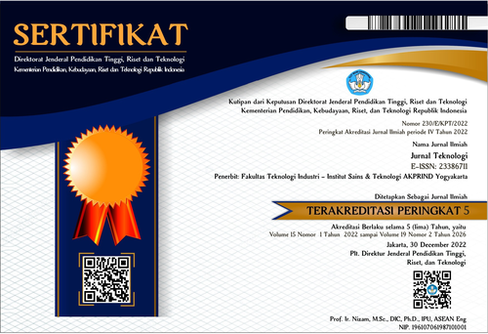Pemanfaatan Limbah Kulit Pisang Kepok untuk Produksi Bioetanol dengan Proses Hidrolisis Asam Klorida
DOI:
https://doi.org/10.34151/jurtek.v16i2.4329Keywords:
Bioethanol, banana peel waste, fermentationAbstract
To reduce the environmental impact of petroleum-based materials, alternative materials such as bioethanol are used, although in small quantities. The second generation bioethanol is produced from biomass originating from hemicellulose-producing bacteria and bound by lignin, namely Kepok banana peel waste. The aim of this research is to find out whether Kepok banana peel waste can be an alternative raw material for making bioethanol using the hydrochloric acid hydrolysis method, which is a good method for the process of making bioethanol from banana peel waste. The process in this research uses two stages, namely the pretreatment stage and the hydrolysis process stage. Lignin is dried through a chemical delignification process, namely by soaking banana peel shells in 10% NaOH solution with a mass ratio of 1:6 (w/v) for 12 hours. After the raw materials are delignified, their contents are tested using the Chesson Datta method. The 10% NaOH delignification method was able to reduce lignin levels in Kepok bananas (36.6%), hemicellulose (11.1%), and cellulose levels (62.8%). The fermentation process uses a starter made from bread yeast with a concentration of 1.4%, urea nutrition with a concentration of 1%, and NPK nutritional variations of 0.6%, 0.8% and 1.0% for three days. The substrate has a volume of 150 ml and is then allowed to ferment until it is no longer thick. The best Kepok banana peel bioethanol (6.5%) in a volume of 17ml comes from NPK (0.8%), the final result is that Kepok banana peel waste can be an alternative to bioethanol.
Downloads
References
Arindhani, S. 2015. Produksi Bioetanol Menggunakan Ragi Roti Instan Dengan dan Tanpa Pemberian Aerasi pada Media Molases. Universitas Jember.
Badan Pusat Statistik Provinsi Jawa Timur. Produksi Buah-Buahan Menurut Jenis Tanaman Menurut Kabupaten/Kota Di Provinsi Jawa Timur Tahun 2017 2020 update terakhir 2021 (diakses tanggal 3 April 2022)
Behera, S. S., dan R. C. Ray. 2016. Solid state Fermentation for Production of Microbial Cellulases: Recent Advances and Improvement Strategies. International Journal of Biological Macromolecules 86 ,656-669.
Darmodjo, V. V. 2020. Produksi Bioetanol Kulit Pisang Kepok (Musa Paradisiaca L.) Dengan Variasi Hidrolisis Asam Dan Lama Fermentasi. Thesis. Universitas Atma Jaya Yogyakarta.
Ferdaus, F., M.O. Wijayanti, E.S Retnonigtyas, dan W. Irawati. 2008. Pengaruh pH, Konsentrasi Substrat, Penambahan Kalsium Karbonat Dan Waktu Fermentasi Terhadap Perolehan Asam Laktat Dari Kulit Pisang. Widya Teknik, 7(1), 1-14.
Danmaliki, G. I., A. M. Muhammad, A. A. Shamsuddeen dan B.J. Usman. 2016. Bioethanol Production From Banana Peels. IOSR Journal of Environmental Science, Ver. II, 10(6), 56-62.
Lestari, M. D., S. Sudarmin dan H. Harjono. 2018. Ekstraksi Selulosa dari Limbah Pengolahan Agar Menggunakan Larutan NaOH sebagai Prekursor Bioetanol. Indonesian Journal of Chemical Science, 7(3), 236-241.
Mardina, P., A. I. Talalangi, J.F. Sitinjak, A. Nugroho, & Fahrizal, M. R. 2013. Pengaruh Proses Delignifikasi Pada Produksi Glukosa Dari Tongkol Jagung Dengan Hidrolisis Asam Encer. Jurnal Konversi, 2(2), 17-23
Nasution, H. I., R.S Dewi dan P. Hasibuan. 2016. Pembuatan Bioetanol dari Rumput Gajah (Pennisetum purpureum schumach) Menggunakan Metode Hidrolisis Asam dan Fermentasi saccharomyces cerevisiae. Jurnal Pendidikan Kimia, vol. 8, no. 2, 144-151.
Nulhakim, L., R.R. Febriana, B. Anggono, H. Lukmana, F. Erviana, A.D. Pratiwi, dan P. N. Azizah. 2019. Pembuatan Bioetanol Dari Kulit Nanas Oleh Saccharomycesm Cerevisiae Terimobilisasi Dalam Butiran Alginat. Applicable Innovation of Engineering and Science Research (AVoER), 444-448.
Downloads
Published
How to Cite
Issue
Section
License
Copyright (c) 2023 Mukasi Wahyu Kurniawati

This work is licensed under a Creative Commons Attribution 4.0 International License.
Jurnal Teknologi provides immediate open access to its content in order of making research freely available to the public to support a global exchange of knowledge. All articles published in this journal are free for everyone to read and download, under licence CC BY SA.
Benefits of open access for the author, include:
- Free access for all users worldwide.
- Authors retain copyright to their work.
- Increased visibility and readership.
- No spatial constraints.




















